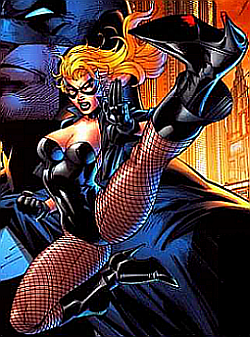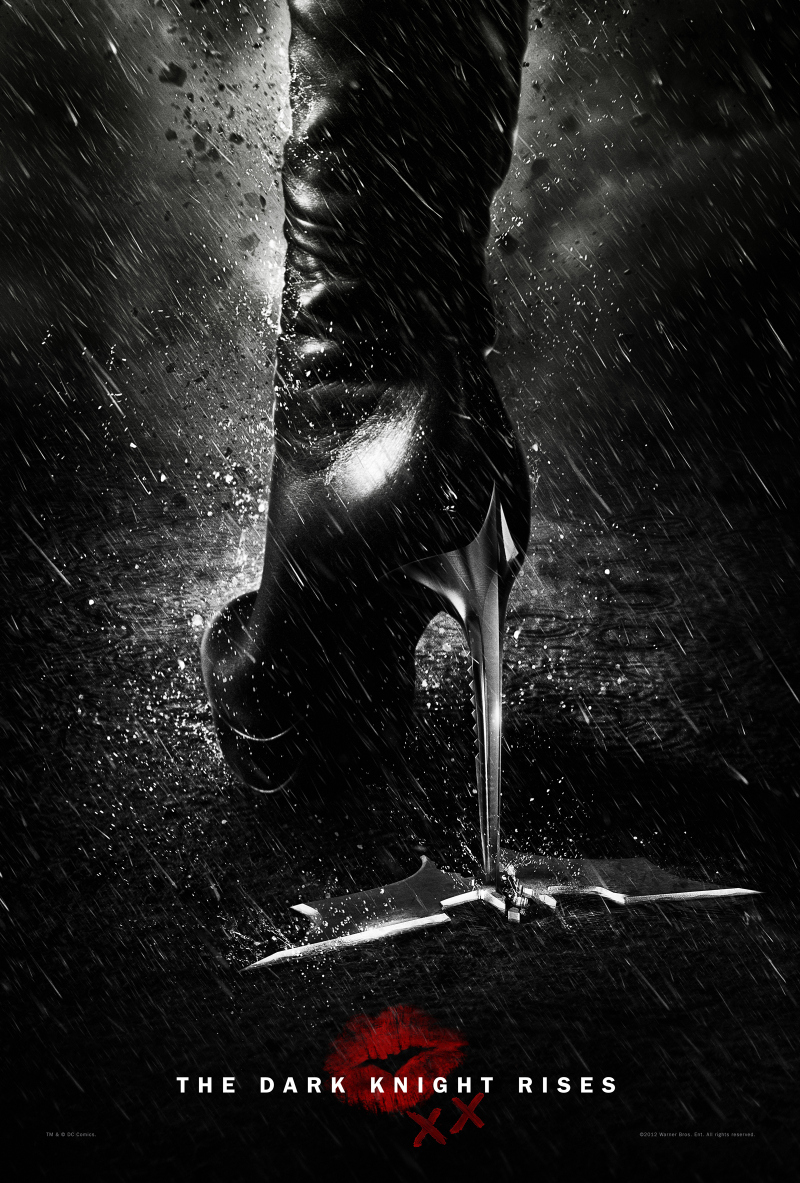
Image Credit: TV Tropes Wiki
Look closely. There's blood spattered on Black Canary's stiletto. The splash of red suggests that immediately before launching herself into this flying kick she put the heel of her fashionable shoe right through some villain's skin, intentionally using the deadly-looking point to her advantage. Juxtaposed against the Batwoman cover I used last week, it's difficult not to notice a few things about this action shot. For one, Black Canary's trademark fishnets are in full-throttled evidence, drawing the line of sight away from the kick itself and down to her immaculately posed, well-endowed torso. I had to look at this image several times to even notice the blood on her shoe. Batwoman, comparatively, seems a bit more clunky, more roughshod, more loyal to the demands of physics. Black Canary, here, is idealized, positioned in an anatomically unfriendly, spine-twisting way in order to showcase her breasts, hips and legs. The stilettos, perhaps, add to that sense of idealization: the very pinnacle of what's possible for the female body appearing in toto with Black Canary's pose. Neither the idealization of the female body or superhero high heels, each exemplified in this image, can be considered an isolated incident. The TV Tropes Wiki examines the popular trend of “combat stilettos” in superhero fiction, and a future blog post will discuss how the female body has been traditionally represented in comics. The heels, however, demand our attention today.
In Christopher Nolan's most recent Batman movie, The Dark Knight Rises, Catwoman also sports an incredibly wicked pair of combat stilettos.

Image Credit: Batman-news.com
Nolan's Batman films already walk the line between the campy comic-book universe of highly saturated colors and the practical reality of the everyday, coming down somewhere in the middle with a dark realism he constantly struggles to assert against the unlikelihood of superhero culture. For example, the Batmobile, that iconic, somewhat silly symbol of bat-justice, becomes the gritty lovechild of a tank and a humvee, the product of Wayne Enterprises weapons research for the military. I half-expected Nolan to give Catwoman a costume that emphasized pragmatism and fit in with his drive for realism (in other words, complete with flats), but instead Anne Hathaway made her Selina Kyle debut with heels roughly as long as the film's midnight showing lines. Interestingly enough, Nolan gestures towards a realist explanation for this choice. In one scene, a thug sneeringly asks Catwoman whether such impractical footwear makes it difficult to walk. She snidely thwacks him with her heel and playfully asks, “I don't know. Do they?” The audience's takeaway from this scene is that these heels are basically specialty weapons. They're impractical the way any armament is impractical; they require certain skills.
Girl culture, then, has become a powerful weapon, one requiring great proficiency and talent to wield. Granted, there are critics who remain concerned about the physical cost of some of fashion's demands, for superheroes and citizens both, but Hathaway's brand of strength, symbolized by her deadly shoes, adds a distinctly feminine twist to the male-dominated world of crime fighting. Perhaps where Batwoman make the concession of giving up outward girl culture in order to adopt a masculine martial style, Catwoman's heels signal the validity of interests culturally coded as feminine. All of a sudden, stilettos seem less a hindrance or a mark of weakness than a respectable symbol of both physical mastery and feminist pride.
The connection between girl culture and superhero strength even takes a real-world, physical turn in Anne Hathaway's own comments at a press conference for Nolan's movie. USA Today's Bryan Alexander reports, “Hathaway credited her breakout role as a magazine editor assistant in 2006's Prada as fundamental training her for the required action in Dark Knight. It gave her the leg up on the skills needed to kick right alongside Batman (Christian Bale)...'The Devil Wears Prada was really good training for that,' Hathaway said at a press conference on Sunday. 'I kind of ran all up and down Manhattan then. Now I just ran up and down Gotham.'” The leap from an editor's assistant to supercrook-turned-hero isn't all that large, provided you're wearing the right shoes.


Recent comments
2 years 29 weeks ago
2 years 44 weeks ago
2 years 44 weeks ago
2 years 50 weeks ago
3 years 4 weeks ago
3 years 4 weeks ago
3 years 4 weeks ago
3 years 6 weeks ago
3 years 6 weeks ago
3 years 6 weeks ago